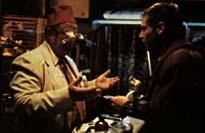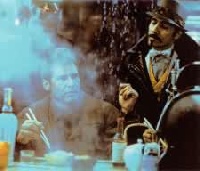Paul M. Sammon Interview
| What is BR? |
| News & Views |
| The FAQ |
| Encyclopedia |
| Quotes |
| People |
| Locations |
| Scripts |
| Analysis |
| Fan-tastic |
| BR Fun |
| BR Game |
| BR Magazine |
| BR Comic |
| Downloads |
| Collectibles |
| Related |
| Links |
| Site Info |
| Search Site |
BRmovie.com is the Home of Blade Runner - the current Blade Runner FAQ, news, resources, links, quotes, scripts and everything else Blade Runner.

![]()
Blade Runner
Buy this Mini Poster at AllPosters.com
|
Any
Comments?
Please e-mail the Webmaster |
| Want the DVD? Or the BR Game? Don't know which books or music to get? Maybe you'd like a Deckard action figure? Make sure you check the BR Related section for all your BR choices. |
|
PS: The answers to your last three questions, at least as far as I'm aware of, are no, marginally, and no. I'm fairly sure Moebius never visited the BR set, and that he didn't submit any designs for the film. I've certainly never met him. Ridley did once show me some of the beautiful, large-format art Moebius contributed for the Nostromo crew's uniforms and "samurai" spacesuits in Alien, which Ridley seemed very proud to have. Then again, Ridley's always been impressed with Moebius's style. Indeed, a lot of the Ridleygrams Scott drew during BR to show his art department looked very much like Moebius art. That was intentional; Ridley was aping Giraud's style, to explain to the production how he wanted Blade Runner to look. Which was like an adult comic book. That's a phrase Scott constantly used to describe the film while it was being prepped, by the way. An adult comic book.
But let me swerve off the road again for a second. Since you mentioned using the IMDb, or Internet Movie Database for research, well, my advice has always been, "Take what you read there with a grain of salt." Or maybe an entire salt mine. Because a distressingly disproportionate amount of info on the IMDb is inaccurate. Just plain wrong. IMDb usually gets the broad strokes right, but if you go to that site for the finer dabs of paint, the more obscure details of a production - beware.
PS: Nope. He's still M.I.A. The problem is, Abdul had a very small part. A day player's, really. And he may - may - have had his real voice dubbed over by another performer during looping. Which has made tracking down Abdul even more troublesome. But I'm still on the case. N: A few background questions about general life on set. What was the catering like? What was the standard meal there? Did anybody use "Eddie's" language a lot on set? What did sets smell like? Did you resort to wearing a facemask like some of the crew? PS: The catering on most shoots, especially higher-budgeted ones, is almost always good. You're usually served two meals a day, and the menu on BR ran the usual gamut; eggs, potatoes, breakfast meats, cereals, juices, steaks, pasta, fish, salads, vegetables, stuffed peppers, deserts, the whole nine yards. The funny thing about catering, though, is that no matter how good the cooks or menus are, eventually the crew starts thinking they're being served the same thing too often. Then the grumbling starts. But providing your cast and crew with good food is very, very important - what was it Napoleon said about armies winning wars with their stomachs, not their weapons? You have to keep your people well-fed. That not only insures that you'll keep a cast and crew's strength up - making films is exhausting - but it goes a long way towards maintaining their good will, too.
Now, how did the set smell? Well, the Warners backlot, the "X" intersection and New York street where the BR sets were built, usually exuded two distinct aromas - smoke and water. Sometimes it seemed like there were rainbars or smokers being used for every damn shot in Blade Runner. So after awhile the backlot started to smell a little, uh, mildew-y. Scott's crew used so many different kinds of smoke and charcoal and incense that those odors seeped into everything. Specific aromas also popped up during specific scenes. Like the noodle bar; you had the fragrance of fish heads, boiled noodles, rice, coffee and God knows what else wafting around that set. And yeah, sometimes I HAD to wear a facemask, again because of the rain and soot. Blade Runner wasn't the worst "smoke experience" I've had on a set, though. That honor would have to go to David Lynch's Dune, which I worked on back in 1982-84. David didn't think the usual smoke effects were reading darkly enough on film. So he started burning automobile and truck tires - big ones! - during some miniature and live-action shots. Which was awful! You just haven't lived until you've spent 12 hours breathing burning tires, and then another picking bits of crispy rubber out of your hair when you get back to your hotel room. But hey - David got his blacks!
|

 N:
Jean "Moebius" Giraud. One of the original talents behind
Métal Hurlant and subsequent Heavy Metal magazines
that Ridley Scott used as inspiration. Scott reportedly wanted him
on the film, but he was unavailable at the time. Yet he is listed
on the IMDb as an uncredited member of the costume design team.
He worked as a concept artist on Scott's film, Alien and
was a production designer alongside Syd Mead on Tron. I have
always wondered exactly what his involvement with Blade Runner
really was. Did he visit the set? Was he involved in any of the
creation? Did you meet him?
N:
Jean "Moebius" Giraud. One of the original talents behind
Métal Hurlant and subsequent Heavy Metal magazines
that Ridley Scott used as inspiration. Scott reportedly wanted him
on the film, but he was unavailable at the time. Yet he is listed
on the IMDb as an uncredited member of the costume design team.
He worked as a concept artist on Scott's film, Alien and
was a production designer alongside Syd Mead on Tron. I have
always wondered exactly what his involvement with Blade Runner
really was. Did he visit the set? Was he involved in any of the
creation? Did you meet him? There
also once was a story in Heavy Metal which had been illustrated
by Moebius and written by Dan O'Bannon called, I think, "The
Long Tomorrow". That was a futuristic detective story set in
a crowded, beehive-like metropolis. I know Ridley was aware of that
piece as well. I'll let you draw your own conclusions as to how
much that influenced BR.
There
also once was a story in Heavy Metal which had been illustrated
by Moebius and written by Dan O'Bannon called, I think, "The
Long Tomorrow". That was a futuristic detective story set in
a crowded, beehive-like metropolis. I know Ridley was aware of that
piece as well. I'll let you draw your own conclusions as to how
much that influenced BR. N:
Another missing person - have you found out yet who played Abdul
Ben-Hassan?
N:
Another missing person - have you found out yet who played Abdul
Ben-Hassan? As
for Eddie Olmos and the bit player who portrayed the cop who arrested
Deckard at the noodle bar, they were the only two people I ever
saw getting into Cityspeak. I mean, a lot of the Cityspeak phrasing
came from Olmos' own linguistic research, right? And Eddie was really
the only one who got to speak it at any length in the film. Therefore,
there wasn't much reason for the other performers to be too interested
in Cityspeak. Besides, technical dialogue, the scientific jargon
you hear on Star Trek, for example, is hard enough for most
actors to memorize and recite. Just imagine them trying to master
something like Cityspeak!
As
for Eddie Olmos and the bit player who portrayed the cop who arrested
Deckard at the noodle bar, they were the only two people I ever
saw getting into Cityspeak. I mean, a lot of the Cityspeak phrasing
came from Olmos' own linguistic research, right? And Eddie was really
the only one who got to speak it at any length in the film. Therefore,
there wasn't much reason for the other performers to be too interested
in Cityspeak. Besides, technical dialogue, the scientific jargon
you hear on Star Trek, for example, is hard enough for most
actors to memorize and recite. Just imagine them trying to master
something like Cityspeak!